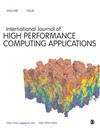Parthenon——一种性能可移植的块结构自适应网格细化框架
IF 2.5
3区 计算机科学
Q2 COMPUTER SCIENCE, HARDWARE & ARCHITECTURE
International Journal of High Performance Computing Applications
Pub Date : 2022-02-24
DOI:10.1177/10943420221143775
引用次数: 3
摘要
在扩大规模的道路上,计算机设备架构和相应的编程模型变得更加多样化。虽然可以使用各种低级别性能的可移植编程模型,但应用程序级别的支持却落后了。为了解决这个问题,我们提出了性能可移植的块结构自适应网格细化(AMR)框架Parthenon,该框架源于测试良好且广泛使用的Athena++天体物理磁流体动力学代码,但被推广为各种下游多物理代码的基础。Parthenon采用了Kokkos编程模型,并提供了从多维变量到定义和分离组件的包,再到启动并行计算内核的各种抽象级别。Parthenon分配设备内存中的所有数据以减少数据移动,支持变量和网格块的逻辑打包以减少内核启动开销,并采用单侧异步MPI调用来减少多节点模拟中的通信开销。使用流体动力学迷你应用程序,我们展示了在各种架构上的弱扩展和强扩展,包括AMD和NVIDIA GPU、Intel和AMD x86 CPU、IBM Power9 CPU以及富士通A64FX CPU。在Frontier(第一台TOP500 exascale机器)的最大规模下,该小型应用程序在9216个节点(73728个逻辑GPU)上以≈92%的弱扩展并行效率(从单个节点开始)达到了1.7×1013个区域循环/s。再加上它是一个开放、协作的项目,这使Parthenon成为一个理想的框架,可以针对exascale模拟,在该模拟中,下游开发人员可以专注于他们的特定应用程序,而不是处理大规模并行、设备加速的AMR的复杂性。本文章由计算机程序翻译,如有差异,请以英文原文为准。
Parthenon—a performance portable block-structured adaptive mesh refinement framework
On the path to exascale the landscape of computer device architectures and corresponding programming models has become much more diverse. While various low-level performance portable programming models are available, support at the application level lacks behind. To address this issue, we present the performance portable block-structured adaptive mesh refinement (AMR) framework Parthenon, derived from the well-tested and widely used Athena++ astrophysical magnetohydrodynamics code, but generalized to serve as the foundation for a variety of downstream multi-physics codes. Parthenon adopts the Kokkos programming model, and provides various levels of abstractions from multidimensional variables, to packages defining and separating components, to launching of parallel compute kernels. Parthenon allocates all data in device memory to reduce data movement, supports the logical packing of variables and mesh blocks to reduce kernel launch overhead, and employs one-sided, asynchronous MPI calls to reduce communication overhead in multi-node simulations. Using a hydrodynamics miniapp, we demonstrate weak and strong scaling on various architectures including AMD and NVIDIA GPUs, Intel and AMD x86 CPUs, IBM Power9 CPUs, as well as Fujitsu A64FX CPUs. At the largest scale on Frontier (the first TOP500 exascale machine), the miniapp reaches a total of 1.7 × 1013 zone-cycles/s on 9216 nodes (73,728 logical GPUs) at ≈ 92 % weak scaling parallel efficiency (starting from a single node). In combination with being an open, collaborative project, this makes Parthenon an ideal framework to target exascale simulations in which the downstream developers can focus on their specific application rather than on the complexity of handling massively-parallel, device-accelerated AMR.
求助全文
通过发布文献求助,成功后即可免费获取论文全文。
去求助
来源期刊
CiteScore
6.10
自引率
6.50%
发文量
32
审稿时长
>12 weeks
期刊介绍:
With ever increasing pressure for health services in all countries to meet rising demands, improve their quality and efficiency, and to be more accountable; the need for rigorous research and policy analysis has never been greater. The Journal of Health Services Research & Policy presents the latest scientific research, insightful overviews and reflections on underlying issues, and innovative, thought provoking contributions from leading academics and policy-makers. It provides ideas and hope for solving dilemmas that confront all countries.

 求助内容:
求助内容: 应助结果提醒方式:
应助结果提醒方式:


